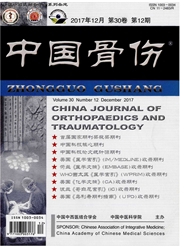

 中文摘要:
中文摘要:
目的:探讨蛇床子素对体外培养的大鼠成骨细胞增殖的影响及机制。方法:新生SD大鼠10只,脱颈处死后取出颅盖骨,剪成约1mm×lmm的碎片,采用胰酶预消化15min,继以0.1%I型胶原酶37℃消化2次,每次1h,所得细胞混匀后置于5%C02培养箱中37℃恒温培养。细胞培养48h、28d后行AIJP染色和矿化结节染色以进行成骨性鉴定。细胞随机分为5组,分别加入终浓度为100、50、25、12.5、0μmol/L的蛇床子素进行干预。24、48、72h后采用CCK-8法检测细胞增殖率,并通过WestemBlot方法检测加药1周后PCNA、β-catenin蛋白表达量。结果:镜下观察细胞形态不规则,具有典型的成骨细胞形态;ALP染色及矿化结节染色均为阳性。CCK-8检测发现100txmol/L的蛇床子素干预24h后即可抑制成骨细胞生长,50μmol/L和25μmol/L的蛇床子素于加药后48h开始抑制成骨细胞生长,12.5μmol/L蛇床子素对成骨细胞的增殖无显著影响。Western Blot检测结果显示PCNA及B-catenin随蛇床子素浓度增加而表达下调。结论:100、50、25μmol/L各个浓度的蛇床子素可抑制成骨细胞增殖,12.5μmol/L蛇床子素对细胞的增殖特性无显著影响。蛇床子素抑制成骨细胞增殖的作用可能是通过干扰Wnt/β-catenin信号通路而实现的。
 英文摘要:
英文摘要:
Objective:To investigate the effects of osthole on proliferation of neonatal rat osteoblast and the mechanism. Methods : Ten 24 hours old SD rats were executed by dislocating. The cranium of rats were removed and cut into blocks of 1 mm×l mm size. After digested by trypsin for 15 min ,the cranium were digested by type I collagenase for one hour two times. The mixed cells were cultured in thermostat incubator with 5% CO2 under the condition of 37℃. To identify the cells, ALP staining and alizarin red staining were performed after cultured 48 h and 28 d. The osteoblasts were randomly divided into five groups. Ceils were treated with osthole at concentrations of 100,50,25,12.5,0 μmol/L. CCK-8 method was used to evaluate the proliferation after 24 h, 48 h and 72 h. The expression of PCNA and 13-catenin protein were detected through the method of Western Blot after one week. Results :The cells had irregular shapes and showed typical features of osteoblast. The results of ALP staining and alizarin red staining were both positive. CCK-8 detection showed that the osthole with final concentration of 100 p, mol/L inhibited the proliferation of osteoblast after 24 h,while the osthole with final concentrations of 50 μmol/L and 25 μmol/L displayed the inhibition effect after 48 h. The osthole of 12.5μmol/L had no obvious influence on the proliferation of osteoblast. The result of Western Blot showed that osthole reduced the expression of PCNA and β-catenin protein in a dose- dependent manner. Conclusion:The osthole with final concentrations of 100,50,25 μmol/L inhibited the proliferation of os- teoblast (P〈0.05). The osthole with final concentrations of 12.5 μmol/L had no obvious influence on the proliferation of os- teoblast (P〉0.05). These findings demonstrate that osthole may inhibit the proliferation of osteoblast by regulating the Wnt/β- catenin signaling in osteoblast.
 同期刊论文项目
同期刊论文项目
 同项目期刊论文
同项目期刊论文
 Ovariectomy-Induced Osteopenia influences the middle and late periods of bone healing in a mouse fem
Ovariectomy-Induced Osteopenia influences the middle and late periods of bone healing in a mouse fem Bufalin inhibits the differentiation and proliferation of human osteosarcoma cell line hMG63-derived
Bufalin inhibits the differentiation and proliferation of human osteosarcoma cell line hMG63-derived Integrative TCM Conservative Therapy for Low Back Pain due to Lumbar Disc Herniation: A Randomized C
Integrative TCM Conservative Therapy for Low Back Pain due to Lumbar Disc Herniation: A Randomized C 期刊信息
期刊信息
